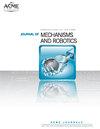PhyNRnet: Physics-informed Newton-Raphson Network for Forward Kinematics Solution of Parallel Manipulators
IF 3.2
4区 计算机科学
Q2 ENGINEERING, MECHANICAL
Journal of Mechanisms and Robotics-Transactions of the Asme
Pub Date : 2023-11-02
DOI:10.1115/1.4063977
引用次数: 0
Abstract
Abstract Despite significant performance advantages, the intractable forward kinematics have always restricted the application of parallel manipulators to small posture spaces. Traditional analytical method and Newton-Raphson method usually cannot solve this problem well due to lack of generality or latent divergence. To address this issue, this study employs recent advances in deep learning to propose a novel physics-informed Newton-Raphson network (PhyNRnet) to rapidly and accurately solve this forward kinematics problem for general parallel manipulators. The main strategy of PhyNRnet is to combine the Newton-Raphson method with the neural network, which helps to significantly improve the accuracy and convergence speed of the model. In addition, to facilitate the network optimization, semi-autoregression, hard imposition of initial/boundary conditions (I/BCs), batch normalization, etc. are developed and applied in PhyNRnet. Unlike previous data-driven paradigms, PhyNRnet adopts the physics-informed loss functions to guide the network optimization, which gives the model clear physical meaning and helps improve generalization ability. Finally, the performance of PhyNRnet is verified by three parallel manipulator paradigms with large postures, where the Newton-Raphson method has generally diverged. Besides, the efficiency analysis shows that PhyNRnet consumes only a small amount of time at each time step, which meets the real-time requirements.基于物理信息的牛顿-拉夫森网络并联机器人正解
尽管并联机器人具有显著的性能优势,但其棘手的正运动学问题一直制约着并联机器人在小姿态空间中的应用。传统的解析方法和Newton-Raphson方法由于缺乏通用性或潜在发散性,往往不能很好地解决这一问题。为了解决这一问题,本研究利用深度学习的最新进展,提出了一种新的物理信息牛顿-拉夫森网络(PhyNRnet),以快速准确地解决一般并联机器人的正运动学问题。PhyNRnet的主要策略是将Newton-Raphson方法与神经网络相结合,这有助于显著提高模型的精度和收敛速度。此外,为了便于网络优化,在PhyNRnet中开发并应用了半自回归、初始/边界条件的硬强制(I/ bc)、批归一化等。与以往的数据驱动范式不同,PhyNRnet采用了告知物理的损失函数来指导网络优化,使模型具有明确的物理意义,有助于提高泛化能力。最后,在Newton-Raphson方法普遍存在分歧的三种大姿态并联机械臂范式中验证了PhyNRnet的性能。此外,效率分析表明,PhyNRnet在每个时间步只消耗少量的时间,满足实时性要求。
本文章由计算机程序翻译,如有差异,请以英文原文为准。
求助全文
约1分钟内获得全文
求助全文
来源期刊

Journal of Mechanisms and Robotics-Transactions of the Asme
ENGINEERING, MECHANICAL-ROBOTICS
CiteScore
5.60
自引率
15.40%
发文量
131
审稿时长
4.5 months
期刊介绍:
Fundamental theory, algorithms, design, manufacture, and experimental validation for mechanisms and robots; Theoretical and applied kinematics; Mechanism synthesis and design; Analysis and design of robot manipulators, hands and legs, soft robotics, compliant mechanisms, origami and folded robots, printed robots, and haptic devices; Novel fabrication; Actuation and control techniques for mechanisms and robotics; Bio-inspired approaches to mechanism and robot design; Mechanics and design of micro- and nano-scale devices.
 求助内容:
求助内容: 应助结果提醒方式:
应助结果提醒方式:


